Abstract
During an etiological study of Kawasaki disease (mucocutaneous lymph node syndrome [MCLS]), we found that dominant viridans streptococcal strains on tooth surfaces and in the throat of both MCLS patients and non-MCLS control children formed erythrogenic and biologically active, extracellular products. In this study, we demonstrated that erythrogenic culture supernatant concentrates of representative strains (two Streptococcus mitis and two Streptococcus oralis), when injected intravenously, induced serum tumor necrosis factor alpha, interleukin-6 (IL-6), and gamma interferon in muramyldipeptide- or Propionibacterium acnes-primed C3H/HeN mice. The concentrates also induced tumor necrosis factor alpha, IL-6, and thymocyte-activating factor (essentially IL-1) in murine peritoneal macrophage, human monocyte, and human whole-blood cultures. An erythrogenic, heat-labile extracellular protein fraction (F-1) that was concentrated from the culture supernatants of a representative S. mitis strain exhibited the above-mentioned cytokine-inducing activity. This partially purified F-1 fraction also induced thymocyte-activating factor and IL-6 in human umbilical vascular endothelial cell and gingival fibroblast cultures.
Full text
PDF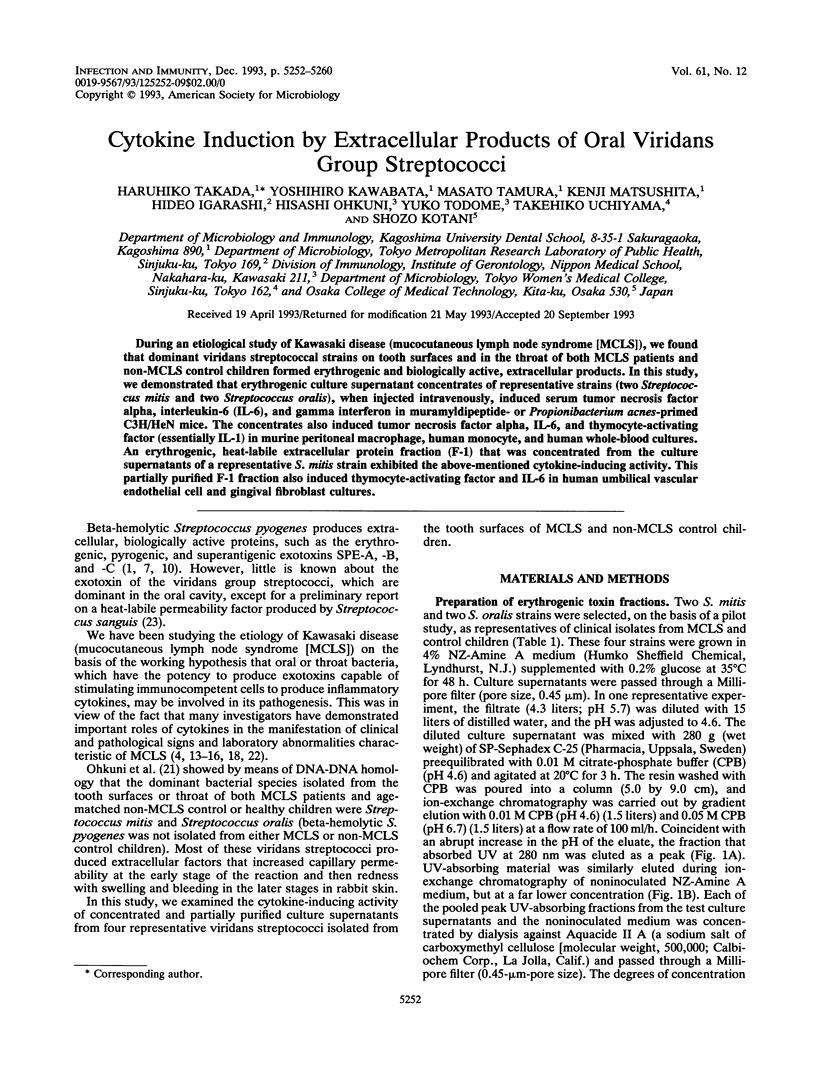
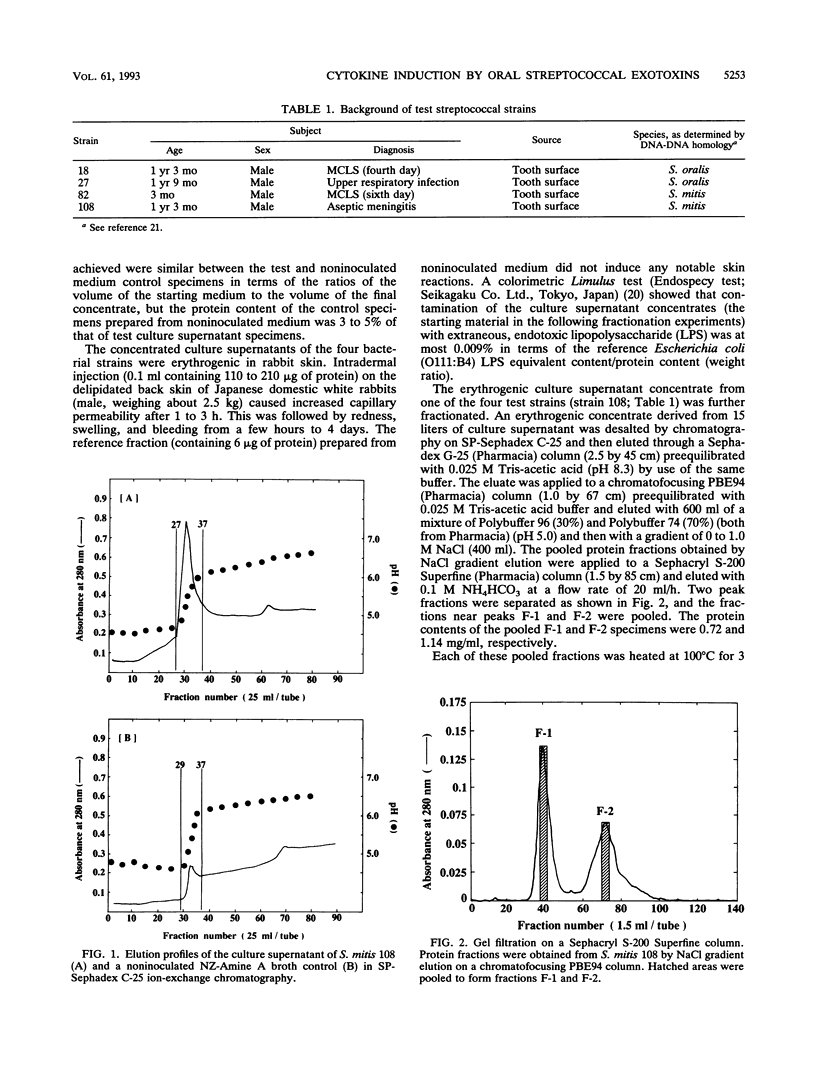
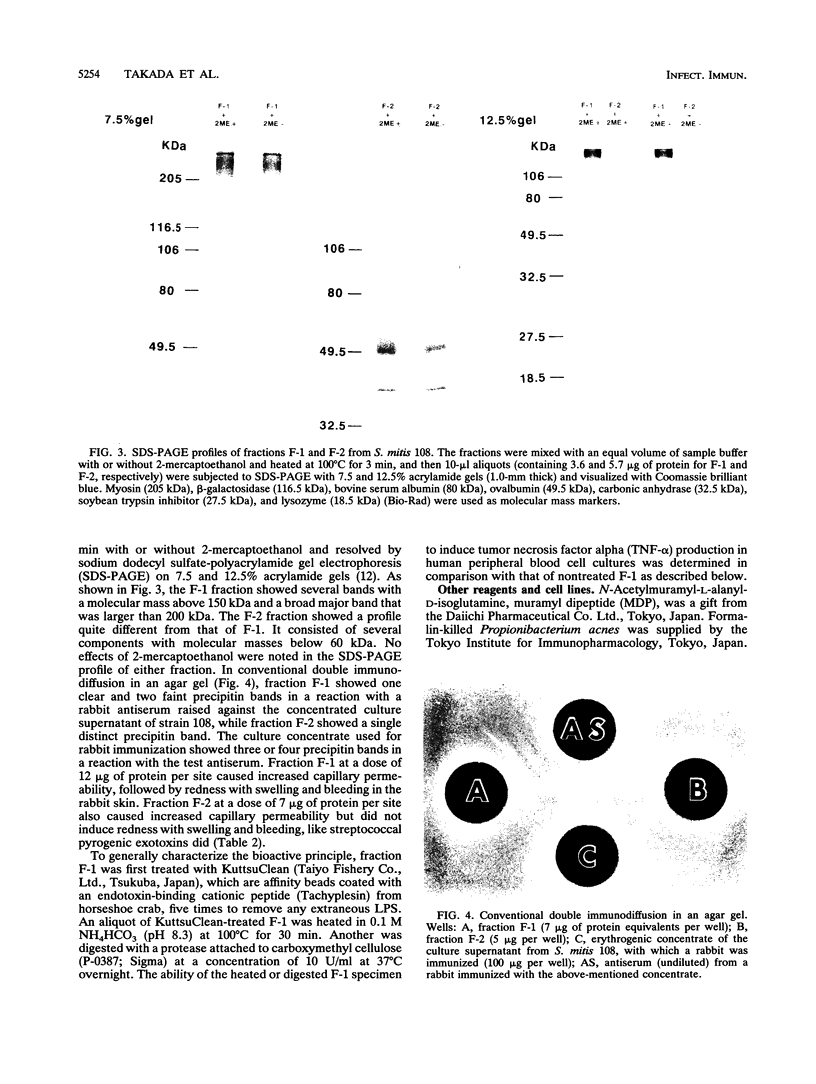
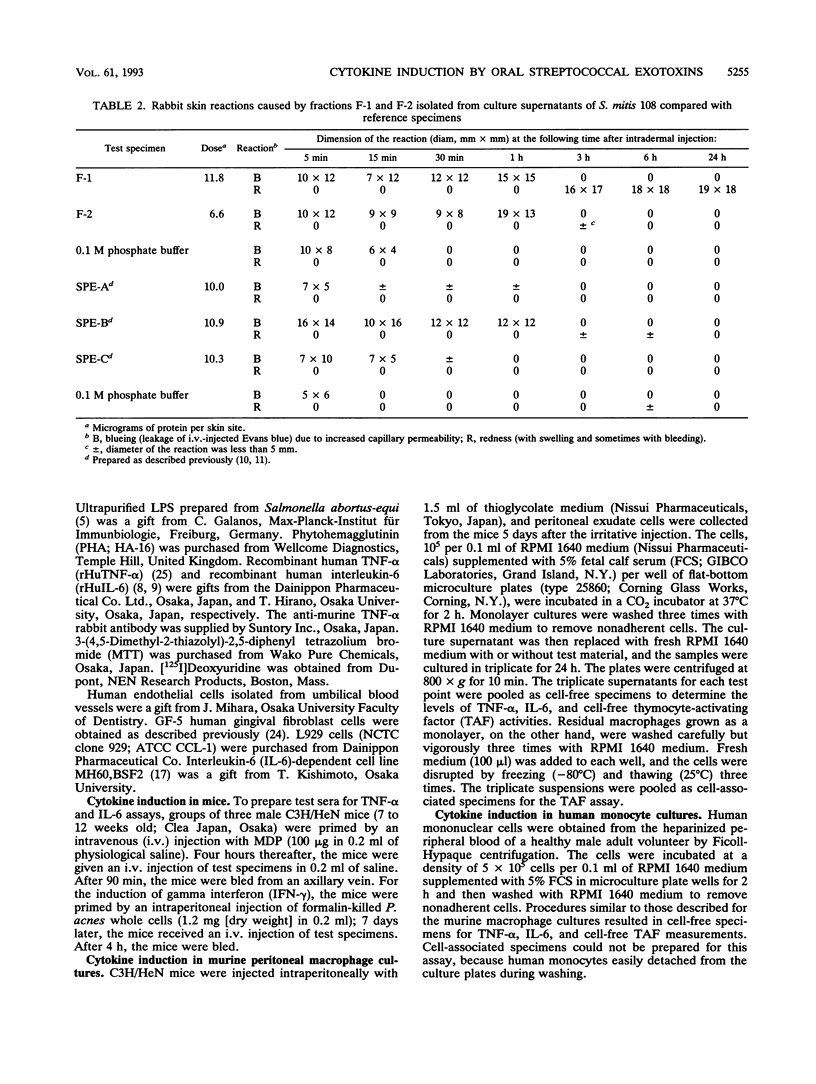

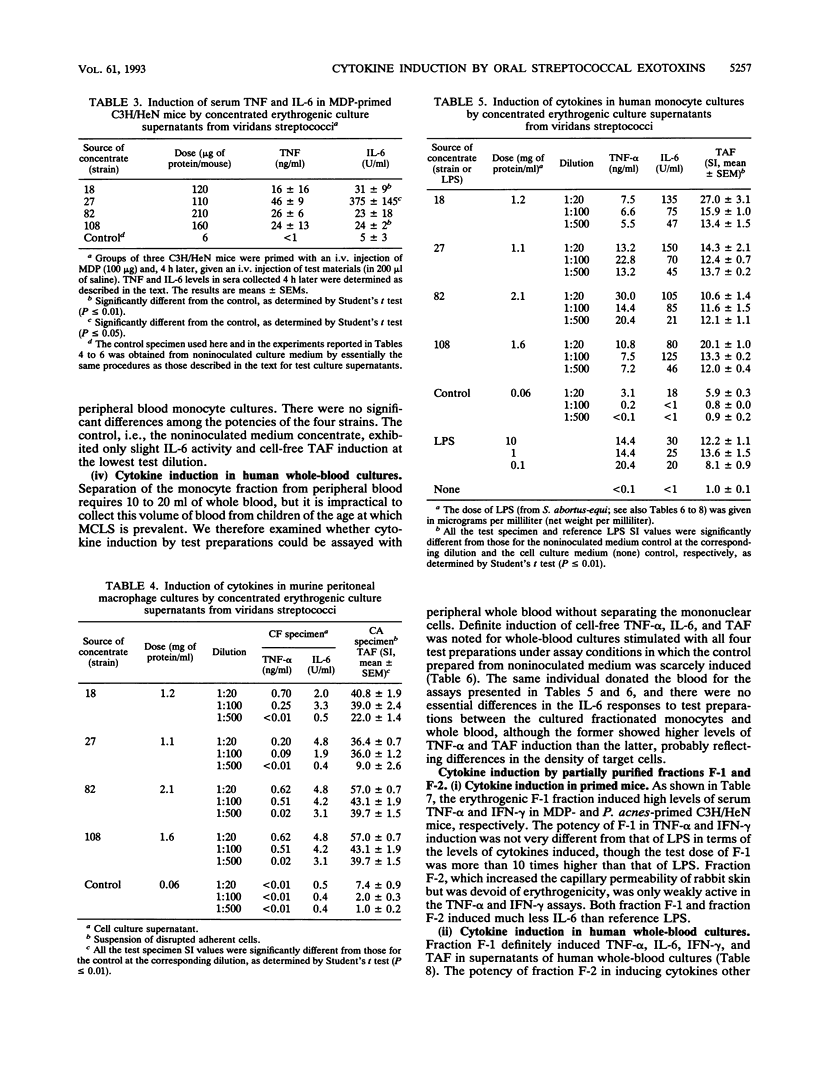
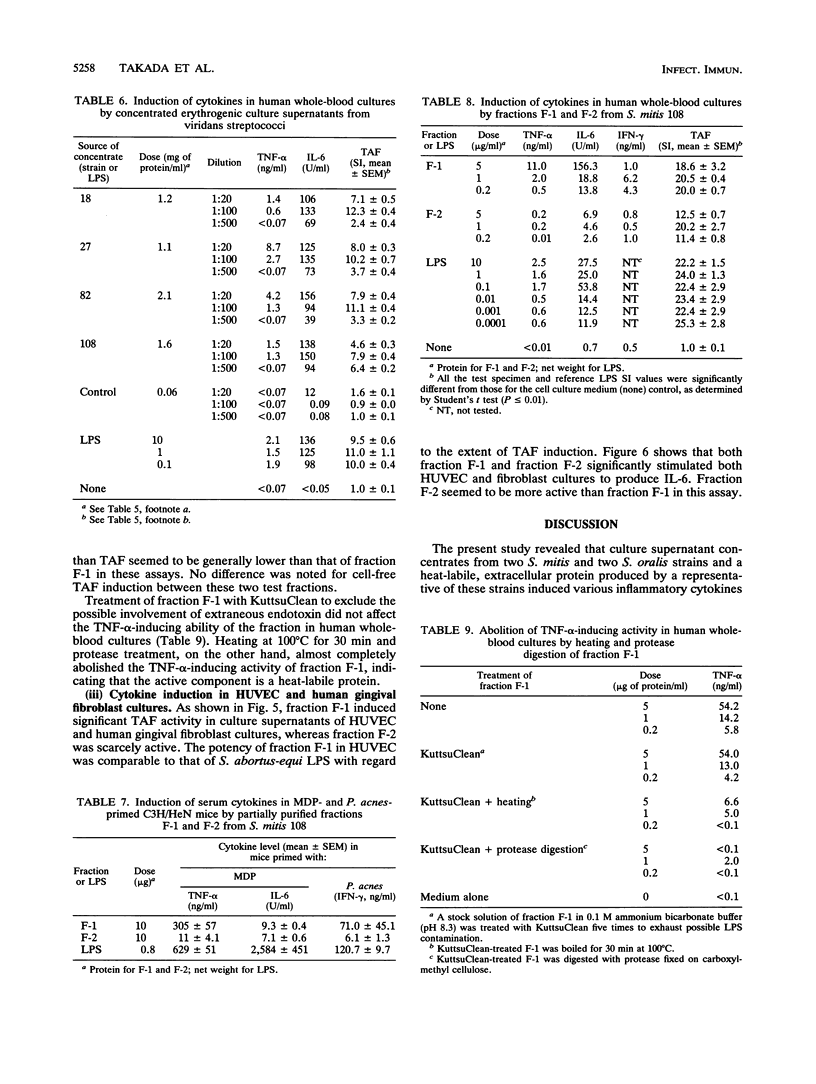
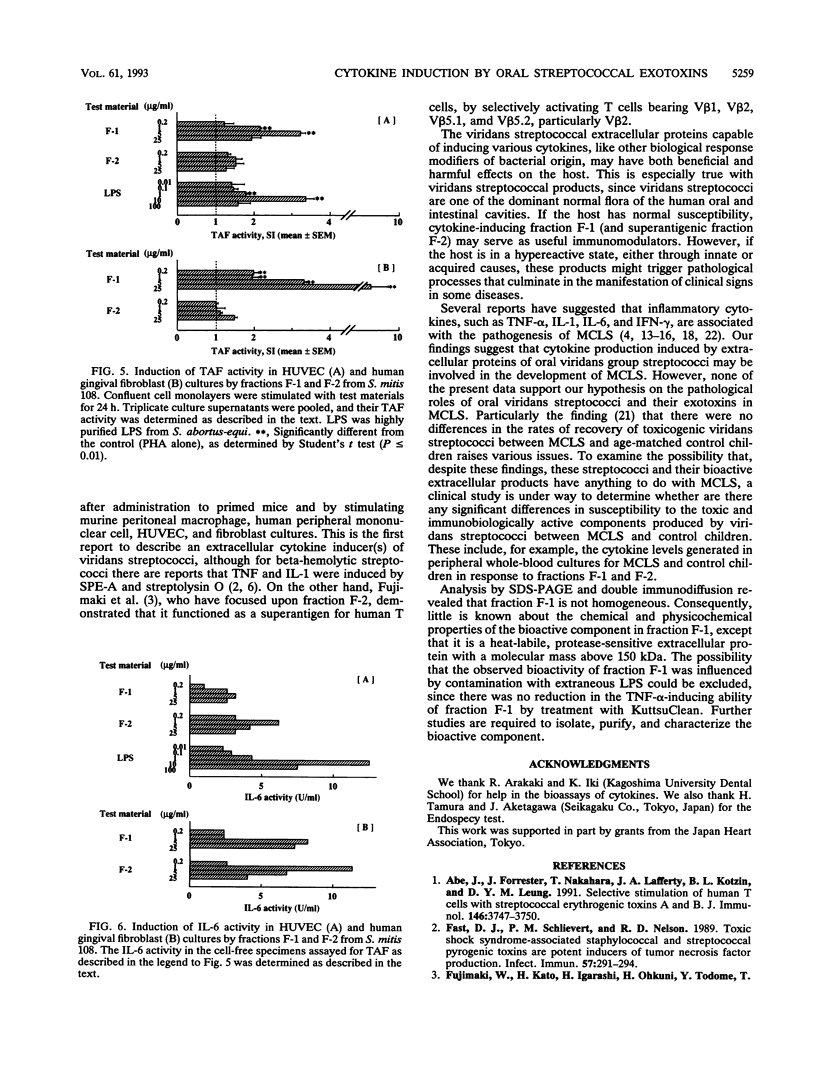
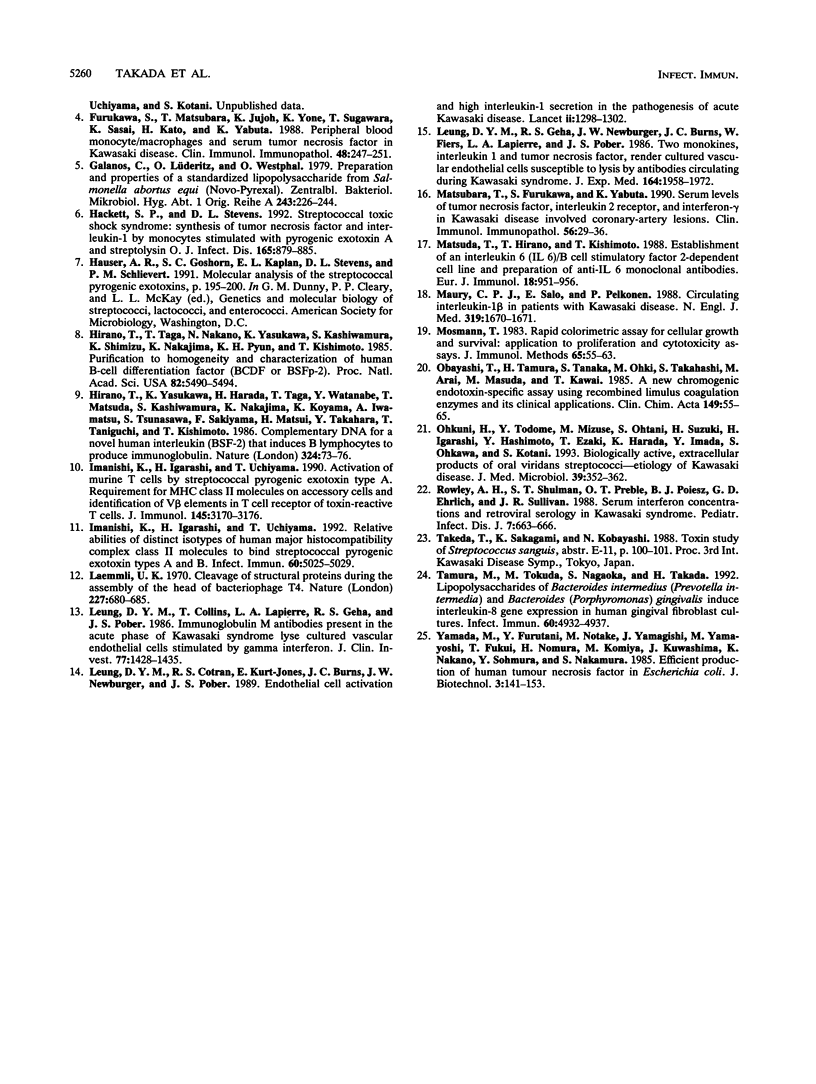
Images in this article
Selected References
These references are in PubMed. This may not be the complete list of references from this article.
- Abe J., Forrester J., Nakahara T., Lafferty J. A., Kotzin B. L., Leung D. Y. Selective stimulation of human T cells with streptococcal erythrogenic toxins A and B. J Immunol. 1991 Jun 1;146(11):3747–3750. [PubMed] [Google Scholar]
- Fast D. J., Schlievert P. M., Nelson R. D. Toxic shock syndrome-associated staphylococcal and streptococcal pyrogenic toxins are potent inducers of tumor necrosis factor production. Infect Immun. 1989 Jan;57(1):291–294. doi: 10.1128/iai.57.1.291-294.1989. [DOI] [PMC free article] [PubMed] [Google Scholar]
- Furukawa S., Matsubara T., Jujoh K., Yone K., Sugawara T., Sasai K., Kato H., Yabuta K. Peripheral blood monocyte/macrophages and serum tumor necrosis factor in Kawasaki disease. Clin Immunol Immunopathol. 1988 Aug;48(2):247–251. doi: 10.1016/0090-1229(88)90088-8. [DOI] [PubMed] [Google Scholar]
- Galanos C., Lüderitz O., Westphal O. Preparation and properties of a standardized lipopolysaccharide from salmonella abortus equi (Novo-Pyrexal). Zentralbl Bakteriol Orig A. 1979 Apr;243(2-3):226–244. [PubMed] [Google Scholar]
- Hackett S. P., Stevens D. L. Streptococcal toxic shock syndrome: synthesis of tumor necrosis factor and interleukin-1 by monocytes stimulated with pyrogenic exotoxin A and streptolysin O. J Infect Dis. 1992 May;165(5):879–885. doi: 10.1093/infdis/165.5.879. [DOI] [PubMed] [Google Scholar]
- Hirano T., Taga T., Nakano N., Yasukawa K., Kashiwamura S., Shimizu K., Nakajima K., Pyun K. H., Kishimoto T. Purification to homogeneity and characterization of human B-cell differentiation factor (BCDF or BSFp-2). Proc Natl Acad Sci U S A. 1985 Aug;82(16):5490–5494. doi: 10.1073/pnas.82.16.5490. [DOI] [PMC free article] [PubMed] [Google Scholar]
- Hirano T., Yasukawa K., Harada H., Taga T., Watanabe Y., Matsuda T., Kashiwamura S., Nakajima K., Koyama K., Iwamatsu A. Complementary DNA for a novel human interleukin (BSF-2) that induces B lymphocytes to produce immunoglobulin. Nature. 1986 Nov 6;324(6092):73–76. doi: 10.1038/324073a0. [DOI] [PubMed] [Google Scholar]
- Imanishi K., Igarashi H., Uchiyama T. Activation of murine T cells by streptococcal pyrogenic exotoxin type A. Requirement for MHC class II molecules on accessory cells and identification of V beta elements in T cell receptor of toxin-reactive T cells. J Immunol. 1990 Nov 15;145(10):3170–3176. [PubMed] [Google Scholar]
- Imanishi K., Igarashi H., Uchiyama T. Relative abilities of distinct isotypes of human major histocompatibility complex class II molecules to bind streptococcal pyrogenic exotoxin types A and B. Infect Immun. 1992 Dec;60(12):5025–5029. doi: 10.1128/iai.60.12.5025-5029.1992. [DOI] [PMC free article] [PubMed] [Google Scholar]
- Laemmli U. K. Cleavage of structural proteins during the assembly of the head of bacteriophage T4. Nature. 1970 Aug 15;227(5259):680–685. doi: 10.1038/227680a0. [DOI] [PubMed] [Google Scholar]
- Leung D. Y., Collins T., Lapierre L. A., Geha R. S., Pober J. S. Immunoglobulin M antibodies present in the acute phase of Kawasaki syndrome lyse cultured vascular endothelial cells stimulated by gamma interferon. J Clin Invest. 1986 May;77(5):1428–1435. doi: 10.1172/JCI112454. [DOI] [PMC free article] [PubMed] [Google Scholar]
- Leung D. Y., Cotran R. S., Kurt-Jones E., Burns J. C., Newburger J. W., Pober J. S. Endothelial cell activation and high interleukin-1 secretion in the pathogenesis of acute Kawasaki disease. Lancet. 1989 Dec 2;2(8675):1298–1302. doi: 10.1016/s0140-6736(89)91910-7. [DOI] [PubMed] [Google Scholar]
- Leung D. Y., Geha R. S., Newburger J. W., Burns J. C., Fiers W., Lapierre L. A., Pober J. S. Two monokines, interleukin 1 and tumor necrosis factor, render cultured vascular endothelial cells susceptible to lysis by antibodies circulating during Kawasaki syndrome. J Exp Med. 1986 Dec 1;164(6):1958–1972. doi: 10.1084/jem.164.6.1958. [DOI] [PMC free article] [PubMed] [Google Scholar]
- Matsubara T., Furukawa S., Yabuta K. Serum levels of tumor necrosis factor, interleukin 2 receptor, and interferon-gamma in Kawasaki disease involved coronary-artery lesions. Clin Immunol Immunopathol. 1990 Jul;56(1):29–36. doi: 10.1016/0090-1229(90)90166-n. [DOI] [PubMed] [Google Scholar]
- Matsuda T., Hirano T., Kishimoto T. Establishment of an interleukin 6 (IL 6)/B cell stimulatory factor 2-dependent cell line and preparation of anti-IL 6 monoclonal antibodies. Eur J Immunol. 1988 Jun;18(6):951–956. doi: 10.1002/eji.1830180618. [DOI] [PubMed] [Google Scholar]
- Maury C. P., Salo E., Pelkonen P. Circulating interleukin-1 beta in patients with Kawasaki disease. N Engl J Med. 1988 Dec 22;319(25):1670–1671. doi: 10.1056/NEJM198812223192515. [DOI] [PubMed] [Google Scholar]
- Mosmann T. Rapid colorimetric assay for cellular growth and survival: application to proliferation and cytotoxicity assays. J Immunol Methods. 1983 Dec 16;65(1-2):55–63. doi: 10.1016/0022-1759(83)90303-4. [DOI] [PubMed] [Google Scholar]
- Obayashi T., Tamura H., Tanaka S., Ohki M., Takahashi S., Arai M., Masuda M., Kawai T. A new chromogenic endotoxin-specific assay using recombined limulus coagulation enzymes and its clinical applications. Clin Chim Acta. 1985 Jun 30;149(1):55–65. doi: 10.1016/0009-8981(85)90273-6. [DOI] [PubMed] [Google Scholar]
- Ohkuni H., Todome Y., Mizuse M., Ohtani N., Suzuki H., Igarashi H., Hashimoto Y., Ezaki T., Harada K., Imada Y. Biologically active extracellular products of oral viridans streptococci and the aetiology of Kawasaki disease. J Med Microbiol. 1993 Nov;39(5):352–362. doi: 10.1099/00222615-39-5-352. [DOI] [PubMed] [Google Scholar]
- Rowley A. H., Shulman S. T., Preble O. T., Poiesz B. J., Ehrlich G. D., Sullivan J. R. Serum interferon concentrations and retroviral serology in Kawasaki syndrome. Pediatr Infect Dis J. 1988 Sep;7(9):663–666. [PubMed] [Google Scholar]
- Tamura M., Tokuda M., Nagaoka S., Takada H. Lipopolysaccharides of Bacteroides intermedius (Prevotella intermedia) and Bacteroides (Porphyromonas) gingivalis induce interleukin-8 gene expression in human gingival fibroblast cultures. Infect Immun. 1992 Nov;60(11):4932–4937. doi: 10.1128/iai.60.11.4932-4937.1992. [DOI] [PMC free article] [PubMed] [Google Scholar]




